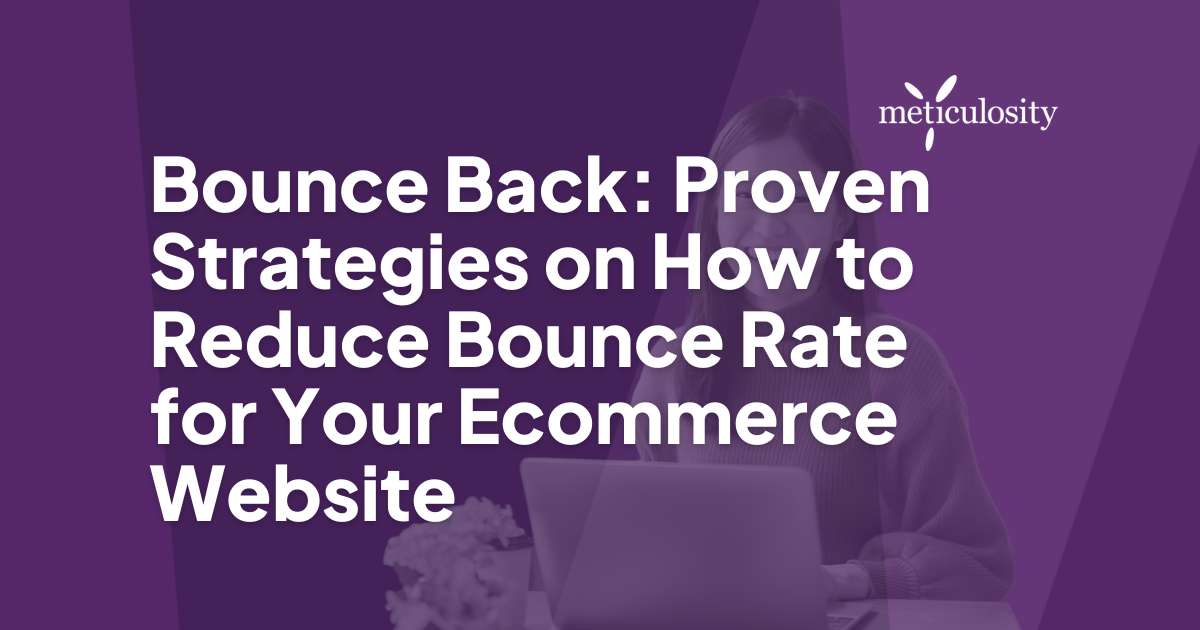Seeing guests bow out of your site faster than a New York minute sure can get your spirits down. We understand the sting of those sky-high bounce rates that seem to take a bite out of your ecommerce dreams. So, we've put together this article to help you navigate back toward lowering the bounce rate and offering the kind of value your readers want to see, keeping them engaged and coming back for more.
Key Takeaways
- Bounce rate is how often visitors leave your website after seeing just one page. A high bounce rate can mean lost sales and lower rankings in search results.
- You can cut down on your website's bounce rate by making pages load faster, having clear calls to action, and showing customers reviews or ratings to build trust.
- Keeping track of how people use your site helps you spot issues. Changing things like headlines or pictures and testing which ones work best can help keep visitors interested.
- Sending emails that speak to what customers like, offering special deals as they're about to leave the site, and keeping content fresh are ways to make people want to stay longer.
- When you find out who wants what you're selling and show them exactly that, they are more likely to stick around and maybe even buy something.
Understanding Bounce Rate and Its Impact on Ecommerce Websites
Bounce rate refers to the percentage of visitors who leave a website without interacting further. High bounce rates can negatively impact ecommerce websites, leading to lower conversion rates and ultimately affecting sales.
Understanding how bounce rate affects your online store is important to strategize on reducing it effectively.
Defining Bounce Rate
Bounce rate tells us how often people leave a website after seeing just one page. Imagine someone clicks on your site and then goes away without clicking anything else. That's a bounce.
For an ecommerce website, it's like someone peeking into a store but walking out immediately.
A high bounce rate can mean the content or layout isn't what visitors want. This might make them less likely to buy something from the site. Every visitor who bounces is a missed chance for a sale, so keeping that number low is key to success online.
Negative Effects of High Bounce Rates on Ecommerce Websites
Now that we know what bounce rate is, let's talk about why high bounce rates can be a problem for ecommerce websites. A high bounce rate often means people are leaving your site without buying anything or looking at more pages.
This isn't good for business. It can mean fewer sales and less money made.
High bounces also tell search engines like Google that maybe your website isn't helpful to visitors. If Google thinks this, it might show your site lower in search results. That makes it harder for new customers to find you online.
Worse yet, if people don't stay on your site long enough, they won’t learn how great your products are!
Looking to empower your brand? Learn how here.
Proven Strategies to Reduce Bounce Rate for Ecommerce Websites
Optimizing page speed is crucial for keeping visitors engaged. Additionally, improving user experience, targeting the right audience, and utilizing visual cues can also significantly reduce bounce rates for ecommerce websites.
Optimize Page Speed
We know how crucial it is for your ecommerce website to load quickly. Shoppers won't wait around if your pages are slow. Here are some ways to make sure your site speed stays on track, keeping visitors happy and engaged:
- Check your hosting plan: Make sure you have the right hosting option for your traffic levels.
- Compress images: Large pictures can slow down pages. Always use tools to shrink image files without losing quality.
- Use a content delivery network (CDN): This helps you spread out your site's files across multiple servers around the world, making it faster for visitors no matter where they are.
- Minimize HTTP requests: Limit how many elements your page needs to load by combining files and reducing scripts, speeding up the whole experience.
- Enable browser caching: When repeat visitors come back, this lets their browser save parts of your pages so they load much faster next time.
- Reduce server response time: Regularly check with your web host about any performance issues and look for ways to improve database efficiency.
- Trim down plugins: Too many add-ons can bog down loading speeds. Remove any that aren't essential or find lighter alternatives.
Improve User Experience
To improve user experience, strive for a clean and intuitive website design. Ensure easy navigation and clear calls-to-action to help users quickly find what they're looking for. Optimize site search functionality so customers can easily locate products or information.
Utilize high-quality visuals and engaging content to keep users interested and make their browsing experience enjoyable. Additionally, prioritize mobile responsiveness to cater to increasing mobile shoppers, creating a seamless experience across all devices.
Moreover, consider personalizing the user experience through tailored recommendations or targeted content based on their behavior and preferences. This can significantly enhance engagement and encourage repeat visits while also boosting conversions.
Target the Right Audience
When targeting the right audience for your ecommerce website, it's crucial to understand who your ideal customers are. Utilize data from your analytics to identify the demographics, interests, and behaviors of visitors who are more likely to engage with your site.
Tailor your content, products, and messaging to resonate with this specific audience. By aligning with the needs and preferences of your target market, you can decrease bounce rates and increase conversions.
Identifying and understanding the right audience allows you to create a tailored user experience that speaks directly to their interests and needs. This alignment helps capture their attention from the moment they land on your site and keeps them engaged throughout their visit.
Utilize Visual Cues
When targeting the right audience, utilizing visual cues effectively is essential. Incorporating compelling images, videos, and infographics can capture visitors' attention and encourage them to explore your website further.
Visual elements help convey information quickly and make the browsing experience more engaging for potential customers. Additionally, strategically placed visual cues can guide users toward key calls-to-action, ultimately reducing bounce rates and increasing conversions on your ecommerce website.
You can create a captivating online environment that resonates with your target audience by using strong imagery and visual storytelling techniques. Engaging visuals can communicate brand messaging effectively while enhancing user experience and encouraging prolonged engagement with your ecommerce platform.
Implement Effective Calls-to-Action
Implementing effective calls-to-action is crucial for reducing bounce rates and improving website conversions. Here are some actionable strategies:
- Ensure clear and compelling CTAs that prompt immediate action.
- Place CTAs strategically on high-traffic pages to capture user attention.
- Use contrasting colors and engaging visuals to make CTAs stand out.
- Create a sense of urgency or exclusivity in your CTAs to drive immediate engagement.
- Test different CTA placements, wording, and designs to optimize for maximum impact.
- Personalize CTAs based on user behavior and preferences to increase relevance.
Regularly Update Website Content
To keep visitors engaged and coming back, it's crucial to regularly update your website content. Fresh content provides value to your audience and signals search engines that your site is active and relevant.
Updating product descriptions and blogs or adding new arrival sections lets you keep the information current and enticing for potential customers. This ongoing effort demonstrates your commitment to offering valuable experiences and helps improve your site's ranking in search results.
Regular updates can also provide opportunities to showcase new products or promotions, encourage repeat visits, and boost conversions.
Utilize Social Proof
To boost confidence and trust in your ecommerce website, utilize social proof such as customer reviews, testimonials, ratings, and endorsements. Displaying real feedback from satisfied customers can reassure potential buyers about the quality and reliability of your products or services.
Additionally, showcasing user-generated content like photos or videos of happy customers using your products can create a sense of community and authenticity that encourages others to make a purchase.
By leveraging social proof effectively on your ecommerce website, you can influence purchasing decisions and reduce bounce rates by providing reassurance and credibility to potential customers.

Additional Tips to Boost Conversions
Utilize Email Marketing, Exit-Intent Popups, and Conduct A/B Testing to further enhance your ecommerce website's performance.
Improve Website Performance
To improve website performance, consider the following strategies:
- Enhance Site Speed: Optimize images and minimize HTTP requests to speed up your website's loading time.
- Streamline Site Navigation: Simplify menu structures and ensure easy access to essential pages for a seamless user experience.
- Implement Responsive Design: Ensure your website is mobile-friendly to cater to increasing mobile users.
- Secure Your Website: Utilize HTTPS protocol and update security features to protect user data and build trust.
- Optimize Site Search: Enhance search functionality to help users find products or information quickly and easily.
- Compress Web Content: Gzip compression can reduce file sizes, loading your web pages faster.
- Minimize Redirects: Limit the use of redirects as they can slow down page load times and lead to higher bounce rates.
- Monitor Website Performance: Regularly check site speed and performance metrics using tools like Google PageSpeed Insights and GTmetrix to identify areas for improvement.
Utilize Email Marketing
Use email marketing to engage with your customers. You send personalized and targeted emails to promote new products, offer exclusive deals, and provide valuable content. By analyzing customer behavior and preferences, you tailor the email content to resonate with their interests and needs.
Through strategic segmentation and automation, you ensure that your emails are relevant and timely, leading to higher open rates and click-through rates. Additionally, you continuously test different elements of your emails, such as subject lines, visuals, and calls to action, to optimize performance for better engagement and conversions.
You aim to build a strong connection with your audience through email marketing. This helps nurture customer relationships over time by delivering value through every interaction.
Utilize Exit-Intent Popups
To further engage website visitors and reduce bounce rates, another effective tactic is to utilize exit-intent popups. These popups are triggered when a user shows signs of leaving the website, such as moving their cursor toward the close button or back arrow.
By capturing the attention of these departing visitors with enticing offers, promotions, or valuable content in a last-ditch attempt to keep them on the site, businesses can potentially convert these almost-lost leads into customers.
It's important to craft compelling and relevant messages that provide real value to users to increase the likelihood of them staying on the website or taking the desired action.
Using exit-intent popups strategically can help lower bounce rates by providing an opportunity for one final interaction with potential customers before they leave. The key is to offer something genuinely helpful or appealing that aligns with their interests or needs.
Conduct A/B Testing
When optimizing your ecommerce website, conducting A/B testing is crucial. It allows you to compare two versions of a webpage to see which one performs better. Here are the steps to conduct effective A/B testing:
- Identify the elements to test, such as headlines, call-to-action buttons, or images.
- Create variations for the selected elements, making specific changes to each version.
- Use A/B testing tools like Google Optimize or Optimizely to split traffic between the original and the variation.
- Set clear goals for what you want to achieve with the test: increased conversions or click-through rates.
- Run the test long enough to gather sufficient data without seasonal biases affecting results.
- Analyze the data collected from the test and draw conclusions based on statistical significance.
- Implement changes based on the winning variation to optimize your website for improved performance.
The Importance of Analytics in Reducing Bounce Rate
Utilizing website analytics is crucial in identifying pages with high bounce rates and tracking and testing changes to improve user engagement. Understanding the data behind visitor behavior can help ecommerce businesses make informed decisions to reduce bounce rates and boost conversions.
Utilizing Website Analytics
Use website analytics to track visitor behavior. Analyzing these data lets you identify pages with high bounce rates and understand user engagement patterns. This helps you make informed decisions on improving your website's performance and reducing the bounce rate.
This information allows you to test changes and track their impact over time.
Using website analytics lets you gain insights into what is working well and what needs improvement. This allows you to optimize your website for better user experience and increased conversions.
Identifying Pages with High Bounce Rates
Identifying pages with high bounce rates is crucial for improving website performance. Begin by analyzing your website analytics to pinpoint the specific pages experiencing high bounce rates. Look for patterns such as common entry points or keywords leading to high bounce rates. Check the user behavior flow to identify which pages have the highest drop-off rates. Pay attention to pages with low average time on page and high exit percentages, indicating potential bounce rate issues.
Tracking and Testing Changes
Tracking and testing changes are crucial to understanding what works best for reducing bounce rates on ecommerce websites. Here are the steps to effectively track and test changes:
- Utilize website analytics data to track user behavior and identify pages with high bounce rates.
- Test different elements such as call-to-action buttons, visuals, and content layout to see which ones resonate best with your audience.
- Implement A/B testing by creating variations of web pages to compare performance and determine the most effective design.
- Monitor the impact of changes over time and make adjustments based on the insights gained from tracking user interactions.

Conclusion
In conclusion, reducing the bounce rate for ecommerce websites is crucial for improving user engagement and conversions. Businesses can effectively lower bounce rates by optimizing page speed, enhancing user experience, and targeting the right audience.
Implementing visual cues, effective calls-to-action, and utilizing social proof are proven strategies to engage visitors and keep them on the website longer. With regular monitoring of analytics data and making necessary adjustments based on insights gained, businesses can continually work toward minimizing bounce rates and maximizing online success.
Click here to learn more about Inbound Marketing.
FAQs
1. What is bounce rate, and why is it important for an ecommerce website?
Bounce rate is the percentage of visitors who navigate away from a website after viewing only one page. For an ecommerce website, a high bounce rate can indicate that visitors are not engaging or converting as desired. It's important because a low bounce rate suggests that visitors find the website relevant and engaging and are exploring multiple pages, which is crucial for driving sales and conversions.
2. What are proven strategies to reduce the bounce rate for an ecommerce website?
-
Optimize Page Load Speed: Ensure fast loading times for all pages, especially product pages, to prevent users from leaving due to slow loading.
-
Improve Website Navigation: Make navigation intuitive with clear menus, categories, and a user-friendly search function, helping visitors find what they're looking for quickly.
-
Mobile Optimization: Ensure that the website is fully responsive and optimized for mobile devices, as an increasing number of users shop on smartphones.
-
Clear Call-to-Action (CTA): Place prominent and compelling CTAs on each page, guiding visitors on the next steps and encouraging them to explore further or make a purchase.
-
High-Quality Product Images: Use high-resolution and multiple images for products to give users a comprehensive view, reducing the likelihood of bouncing due to lack of information.
-
Compelling Product Descriptions: Craft persuasive and informative product descriptions to keep visitors engaged and give them the necessary details.
-
Streamlined Checkout Process: Simplify the checkout process, reducing friction and potential reasons for abandonment during the final stage of the customer journey.
-
Implement Exit-Intent Pop-ups: Use exit-intent pop-ups to capture the attention of users about to leave by offering discounts, promotions, or capturing their email for future engagement.
-
A/B Testing: Experiment with different designs, layouts, and content through A/B testing to identify what resonates best with your audience.
-
Content Personalization: Tailor content based on user behavior, preferences, or past purchases to enhance the overall user experience.
3. How can businesses use analytics to understand and address bounce rate issues?
Businesses can use analytics tools like Google Analytics to monitor bounce rates for different pages, user demographics, and traffic sources. Businesses can pinpoint areas that need improvement by identifying pages with high bounce rates. Analyzing user behavior, such as the time spent on pages, exit pages, and referral sources, provides valuable insights into user preferences and pain points, allowing businesses to tailor strategies accordingly.
4. What role does customer feedback play in reducing bounce rate?
Customer feedback is invaluable in understanding why visitors may be leaving the website. Businesses can collect feedback through surveys, user testing, and reviews to identify areas of improvement. Addressing specific issues raised by customers can lead to enhancements that directly impact bounce rate reduction, fostering a more user-centric ecommerce experience.







